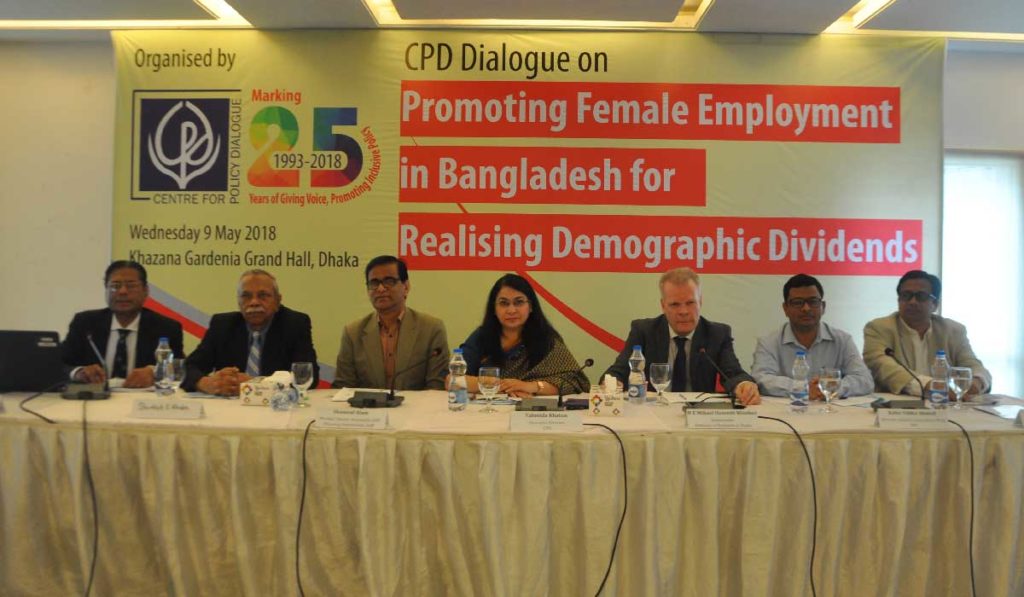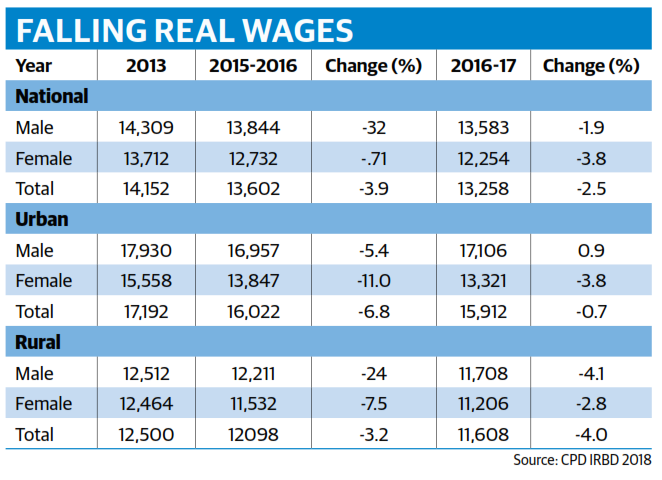The Centre for Policy Dialogue (CPD) has organised a dialogue titled “Realising the Demographic Dividend in Bangladesh: Promoting Female Labour Force Participation” on recent CPD study “Promoting Female Employment in Bangladesh for Realising Demographic Dividends”, and was held at Khazana Gardenia Grand Hall, Dhaka on 9 May 2018.
Published in The Daily Star on Thursday, 9 May 2018
Disquieting trend in job market

Star Business Report
Some 8.5 lakh women lost jobs in the industrial sector between 2013 and 2016-17 — a development that the Centre for Policy Dialogue has termed ‘truly disquieting’.
It appears that many jobs were displaced for adoption of technology by factories after the increase in minimum wages for garment workers, said CPD Distinguished Fellow Mustafizur Rahman at a dialogue yesterday.
Besides, a large number of workers became jobless owing to the closure of sub-contracting factories after the Rana Plaza collapse, he said, citing that the number of employed female in the industry fell to 3.15 million in 2016-17 from 3.99 in 2013.
“The major challenge is to ensure jobs for them,” said Rahman at the discussion organised by the CPD on promotion of female employment to realise the demographic dividends enjoyed by Bangladesh now, held at the Khazana Gardenia Grand Hall.
After analysing the latest Labour Force Survey of the Bangladesh Bureau of Statistics, the independent think-tank said one-third of the working age population above 15 years of age are not in employment, education or training (NEET) And 57 percent of them are women, the CPD said. The figures come at a time when Bangladesh is entering its demographic dividend phase for rising share of working age population out of its total population. Yet, the participation of women in the labour force has not been rising: since 2010 it has been hovering around 36 percent, according to data from the BBS.
Bangladesh’s working age population between 15 to 59 years of age will increase significantly by 2061 and the availability of a large number of young, healthy and educated workers must be seen as a significant advantage for the country.
“Female employment will play an important role in realising the potential benefits accruing from this demographic dividend.”
Labour force participation by women must be seen as an integral component of the jobs agenda.
Out of the total employed population, 18.65 million are female working in agriculture, industry and service sector. Some 92 percent of them work in the informal sector, where wages remain low and jobs remain at stake.
Subsequently, the CPD suggested training and education for women to increase their participation in the job market.
It also recommended blending vocational training with female education to enable greater and gainful labour force participation in the job market to realise the demographic dividend.
Tertiary education has significant impact on labour force participation, it said and subsequently called for ensuring female education beyond the high school level. The think-tank suggested increased budgetary allocation for education in this regard and creation of decent jobs to attain sustainable development goals.
Women’s low participation in the labour force has big implication for economic growth, said Shamsul Alam, member of the Planning Commission.
The rate of participation of women in the job market is much below the global average of 50 percent. “This is a major concern — we have to take steps immediately.” The CPD also found that the real wage is declining.
“The real wage is falling despite rising labour productivity — it should not be. That means there is scope for exploitation,” Alam added.
Mikael Hemniti Winther, the Danish ambassador in Dhaka, said societies that include women in economic activities are doing better.
Barkat-e-Khuda, Muzaffer Ahmad chair professor at the Bangladesh Institute of Bank Management, stressed on education and faster growth of decent jobs to reap benefits of demographic dividend.
Maleka Banu, general secretary of Bangladesh Mahila Parishad, said child and early marriage of women should be stopped.
She also stressed on ensuring safety and security in workplaces as well as recognition of maternal issues by the state and society.
Published in Dhaka Tribune on Thursday, 9 May 2018
CPD: Real wages of female employees fell by 3.8% in a year
Niaz Mahmud
‘Occupational segregation is on the rise in rural areas as new jobs in rural areas are increasingly being taken by men. In professions, women generally do not go to the top level because of the glass ceiling caused by discrimination’
The year-on-year real average wages of female employees have declined by 3.8%, from Tk12,732 in fiscal year 2015-16 to Tk12,254 in 2016-17, according to the Centre for Policy Dialogue (CPD).
According to the think-tank, the overall real average wages during the period have fallen by 2.5%, while the wages of male employees fell by 1.9%.
The CPD disclosed the data at a event called “Promoting Female Employment in Bangladesh for Realizing Demographic Dividends” in Dhaka on Wednesday.
“Occupational segregation is on the rise in rural areas as new jobs in rural areas are increasingly being taken by men. In professions, women generally do not go to the top level because of the glass ceiling caused by discrimination,” said Mustafizur Rahman, a distinguished fellow of the CPD, while presenting the keynote paper at the event.
He said 56.9% of women between 15 to 65+ years in age belong to the “Not in Education, Employment, or Training” (NEET) category.
“It is a matter of concern but also an opportunity if Bangladesh can utilize their potential,” he added.
Planning Commission Senior Secretary Dr Shamsul Alam who attended the event as the chief guest said: “Women’s participation in the labor force is 34% in Bangladesh against a world average of 50%, meaning that the country is wasting resources. The plan will be to reduce the number of jobs in the informal sector and increase the number in the formal sector.”
Bangladesh Institute of Bank Management Chair-Professor Barkat-e-Khuda said: “Two million people were entering the country’s job market every year while 1.4 million people were getting jobs while the remaining 600,000 people remain jobless and the figure is increasing every year at a cumulative rate.”
The worst scenario is that the rate of unemployment is higher among the educated class rather that the uneducated, he added.
Among others, Danish Ambassador Mikael Hemniti Winther, CPD Executive Director Fahmida Khatun, Bangladesh Institute of Development Studies (BIDS) Senior Research Fellow Minhaj Mahmud, and Bangladesh Bureau of Statistics (BBS) Director Kabir Uddin Ahmed, also spoke at the event.
Published in The Financial Express on Thursday, 9 May 2018
Leaving out women could hurt demographic dividend pursuit
56.9pc women not in education, employment, training, says CPD
FE Report
The low participation of women in the work force could seriously hurt Bangladesh’s chance of tapping the demographic dividend, the local think-tank Centre for Policy Dialogue (CPD) has warned.
About 56.9 per cent of women in Bangladesh are not in education, employment and training and as such, the country is missing out on significant opportunities, the CPD has cautioned.
Their observations came at the public dialogue on “Promoting Female Employment in Bangladesh for Realising Demographic Dividends” in the capital on Wednesday.
“Female labour force participation in Bangladesh continues to be significantly lower than their male counterparts,” said CPD Distinguished Fellow Professor Mustafizur Rahman in his keynote presentation.
“While the female labour force’s participation posted a rise between 2000 and 2010, it came down between 2010 and 2013, rising somewhat thereafter to reach the 2010 level in 2016-17”, he added.
Citing some earlier studies done by the CPD, the researchers noted that while the national real average wages in Bangladesh fell by 2.5 per cent between the fiscal year (FY) 2015-16 and the FY 2016-17, for females it declined by 3.8 per cent,
While 85.1 per cent of the total employment in Bangladesh in the FY 2016-17 was in the informal sector-for females, the share was 91.8 per cent, they said.
Noting the country’s failure to take women on board to tap their true contribution to the economy, the CPD researchers also noted that the value of women’s unaccounted labour was equivalent to about 77 to 87 per cent of Bangladesh’s gross domestic product (GDP).
Analysing the prevailing wage gap between males and females, speakers at the programme observed that the overall wage gap originated primarily from the unregulated informal employment.
“The average wage gap between informally-employed male and female employees is 14.3 per cent where 8.4 per cent originates from labour market discrimination against women and 5.9 per cent from characteristics effect”, Mustafizur said.
“Among the sectors, agriculture has the highest wage gap of 17.3 per cent followed by 11.6 per cent in the services sector while the wage gap is lowest in the industrial sector at 9.9 per cent”, he added.
Suggesting remedies for the situation, the CPD researchers have observed that it is important to identify barriers to formalisation and take gradual steps to promote formal employment and formal sectors in the economy.
At the same time, special efforts need to be taken for incentivising women’s employment in the emerging rural non-farm sectors, they said.
“The unpaid household services provided by women should be taken into account in our national accounting system”, said Planning Commission Member Professor Dr. Shamsul Alam.
“We need to find ways and methods of doing it”, Professor Alam said. “Leading economic think-tanks can help us in this regard,” he added.
Noting that the informal sector is often exploitive and less productive offering low wages, the Planning Commission member said, “For inclusive growth, we need to reduce this informal sector as much as possible and as quickly as possible”.
Noting the overwhelming presence of women in the informal sector, Senior Research Fellow of Bangladesh Institute of Development Studies (BIDS) Dr. Minhaj Mahmud said, “The issues of maternity leave and paid overtime need to be addressed in the informal sector to address the plights of women working in such a segment”.
Speakers at the programme also observed that the issue of women labour force’s participation should be accorded more prominence in the upcoming 8th Five-Year Plan, Vision 2041 document and the SDGs implementation plan of the country “Bangladesh’s voluntary national reports (VNRs) in the context of the SDGs should monitor progress with regard to various dimensions of FLFP in light of the relevant SDG targets and indicators,” said Mustafizur.
Highlighting the important role of education in increasing women’s participation in the labour force, the researchers said there is a need to blend vocational training with women’s education to enable greater and gainful labour force participation in job markets of the future.
At the same time, ensuring women’s education beyond the high school level should be seen as an important job market strategy for women, particularly in view of the opportunities of the emerging ‘new economy’, they said.




